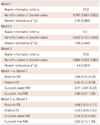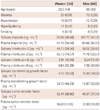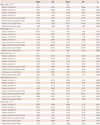1. Gheorghiade M, Bonow RO. Chronic heart failure in the United States: a manifestation of coronary artery disease. Circulation. 1998. 97:282–289.
2. Fahey T, Jeyaseelan S, McCowan C, et al. Diagnosis of left ventricular systolic dysfunction (LVSD): development and validation of a clinical prediction rule in primary care. Fam Pract. 2007. 24:628–635.
3. Hobbs FD. Unmet need for diagnosis of heart failure: the view from primary care. Heart. 2002. 88:Suppl 2. ii9–ii11.
4. Rakhit RD, Seiler C, Wustmann K, et al. Tumour necrosis factor-alpha and interleukin-6 release during primary percutaneous coronary intervention for acute myocardial infarction is related to coronary collateral flow. Coron Artery Dis. 2005. 16:147–152.
5. Aukrust P, Gullestad L, Ueland T, Damås JK, Yndestad A. Inflammatory and anti-inflammatory cytokines in chronic heart failure: potential therapeutic implications. Ann Med. 2005. 37:74–85.
6. Gullestad L, Aukrust P. Review of trials in chronic heart failure showing broad-spectrum anti-inflammatory approaches. Am J Cardiol. 2005. 95:17C–23C. discussion 38C-40C.
7. Aukrust P, Yndestad A, Damås JK, Gullestad L. Inflammation and chronic heart failure-potential therapeutic role of intravenous immunoglobulin. Autoimmun Rev. 2004. 3:221–227.
8. Valgimigli M, Ceconi C, Malagutti P, et al. Tumor necrosis factor-alpha receptor 1 is a major predictor of mortality and new-onset heart failure in patients with acute myocardial infarction: the Cytokine-Activation and Long-Term Prognosis in Myocardial Infarction (C-ALPHA) study. Circulation. 2005. 111:863–870.
9. Pasyk S, Bloor CM, Khouri EM, Gregg DE. Systemic and coronary effects of coronary artery occlusion in the unanesthetized dog. Am J Physiol. 1971. 220:646–654.
10. Slavkin HC. Toward molecularly based diagnostics for the oral cavity. J Am Dent Assoc. 1998. 129:1138–1143.
11. Streckfus CF, Bigler LR. Saliva as a diagnostic fluid. Oral Dis. 2002. 8:69–76.
12. Gheorghiade M, Sopko G, De Luca L, et al. Navigating the crossroads of coronary artery disease and heart failure. Circulation. 2006. 114:1202–1213.
13. Hunt SA, Abraham WT, Chin MH, et al. ACC/AHA 2005 Guideline Update for the Diagnosis and Management of Chronic Heart Failure in the Adult: a report of the American College of Cardiology/American Heart Association Task Force on Practice Guidelines (Writing Committee to Update the 2001 Guidelines for the Evaluation and Management of Heart Failure): developed in collaboration with the American College of Chest Physicians and the International Society for Heart and Lung Transplantation: endorsed by the Heart Rhythm Society. Circulation. 2005. 112:e154–e235.
14. Pfeffer MA, Braunwald E, Moyé LA, et al. The SAVE Investigators. Effect of captopril on mortality and morbidity in patients with left ventricular dysfunction after myocardial infarction. Results of the survival and ventricular enlargement trial. N Engl J Med. 1992. 327:669–677.
15. St John Sutton M, Scott CH. A prediction rule for left ventricular dilatation post-MI? Eur Heart J. 2002. 23:509–511.
16. Zethelius B, Berglund L, Sundström J, et al. Use of multiple biomarkers to improve the prediction of death from cardiovascular causes. N Engl J Med. 2008. 358:2107–2116.
17. Smith JG, Newton-Cheh C, Almgren P, et al. Assessment of conventional cardiovascular risk factors and multiple biomarkers for the prediction of incident heart failure and atrial fibrillation. J Am Coll Cardiol. 2010. 56:1712–1719.
18. Kim HC, Greenland P, Rossouw JE, et al. Multimarker prediction of coronary heart disease risk: the Women's Health Initiative. J Am Coll Cardiol. 2010. 55:2080–2091.
19. Daniels LB, Maisel AS. Multiple marker approach to risk stratification in patients with stable coronary artery disease: to have or have not. Eur Heart J. 2010. 31:2980–2983.
20. Timmers L, Pasterkamp G, de Hoog VC, Arslan F, Appelman Y, de Kleijn DP. The innate immune response in reperfused myocardium. Cardiovasc Res. 2012. 94:276–283.
21. Halawa B, Salomon P, Jołda-Mydłowska B, Zyśko D. [Levels of tumor necrosis factor (TNF-alpha) and interleukin 6 (IL-6) in serum of patients with acute myocardial infarction]. Pol Arch Med Wewn. 1999. 101:197–203.
22. Seta Y, Shan K, Bozkurt B, Oral H, Mann DL. Basic mechanisms in heart failure: the cytokine hypothesis. J Card Fail. 1996. 2:243–249.
23. Oral H, Kapadia S, Nakano M, et al. Tumor necrosis factor-alpha and the failing human heart. Clin Cardiol. 1995. 18:9 Suppl 4. IV20–IV27.
24. Libby P, Okamoto Y, Rocha VZ, Folco E. Inflammation in atherosclerosis: transition from theory to practice. Circ J. 2010. 74:213–220.
25. Libby P, Ridker PM, Maseri A. Inflammation and atherosclerosis. Circulation. 2002. 105:1135–1143.
26. Libby P. Current concepts of the pathogenesis of the acute coronary syndromes. Circulation. 2001. 104:365–372.
27. Libby P, Geng YJ, Aikawa M, et al. Macrophages and atherosclerotic plaque stability. Curr Opin Lipidol. 1996. 7:330–335.
28. Ridker PM, Rifai N, Pfeffer M, Sacks F, Lepage S, Braunwald E. Elevation of tumor necrosis factor-alpha and increased risk of recurrent coronary events after myocardial infarction. Circulation. 2000. 101:2149–2153.
29. Alpert JS, Thygesen K, Antman E, Bassand JP. Myocardial infarction redefined--a consensus document of The Joint European Society of Cardiology/American College of Cardiology Committee for the redefinition of myocardial infarction. J Am Coll Cardiol. 2000. 36:959–969.
30. Lecour S. Activation of the protective Survivor Activating Factor Enhancement (SAFE) pathway against reperfusion injury: does it go beyond the RISK pathway? J Mol Cell Cardiol. 2009. 47:32–40.





 PDF
PDF ePub
ePub Citation
Citation Print
Print






 XML Download
XML Download